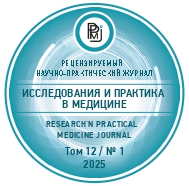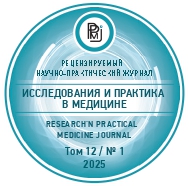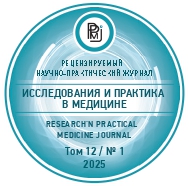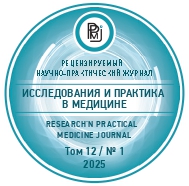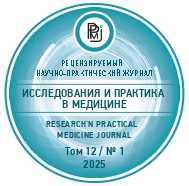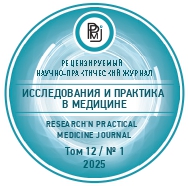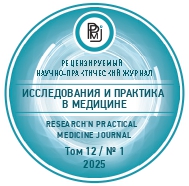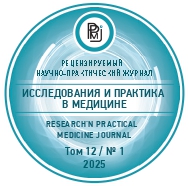Опубликован 21.03.2025 г.
Original Articles
Purpose of the study. To evaluate the results of targeted lymphadenectomy (TLAE) in patients with breast cancer (BC) cT1–3N1M0 after neoadjuvant systemic therapy (NAST).
Patients and methods. The study represents a prospective analysis of 83 patients diagnosed with breast cancer in stage T1–3N1M0 who were treated in the Department of Reconstructive and Plastic Surgery of the breast and skin at the P. Hertsen Moscow Oncology Research Institute (Moscow, Russian Federation). The patients were divided into two groups: in the main group 1 (n = 45), TLAE was performed using a metal tag (clip) after surgery; in the control group 2 (n = 38), classical lymphadenectomy (LAE) was performed. The following characteristics were evaluated: the size of the primary tumor and its localization, the degree of malignan cy (G), the biological subtype of the tumor, the number of sentinel lymph nodes (SLN), the number of metastases in SLN, damage to other lymph nodes, the number of patients who moved from cN1 to cN0. According to these characteristics, the two groups were comparable and there were no statistically significant differences. The effectiveness of NAST was assessed by the frequency of complete pathomorphological regression of the lesion of the studied tissue. The frequency of identification of sentinel lymph nodes was assessed with urgent cytological and routine pathomorphological studies.
Results. In group 1, a complete pathomorphological response in the mammary gland was 37.8 %, in group 2 – 31.6 %. A complete pathomorphological response in the affected lymph node (N0) after neoadjuvant polychemotherapy (NAST) was achieved in 51.1 % of patients in group 1 and 52.6 % in group 2. The frequency of identification of sentinel lymph nodes during biopsy in both groups was 100 %. The frequency of identification of the installed tag was 100 %. The frequency of coincidences of the clipped lymph node with the sentinel lymph node was 65 %. In one case, migration of the installed label was noted. The efficiency of using the navigation explorer was 93 %.
Conclusion. The results obtained confirm the expediency, feasibility and high efficiency of de-escalation of surgical intervention in the form of TLAE. Our study also demonstrates the relative simplicity and accuracy of using a metal tag to achieve TLAE goals.
Purpose of the study. To examine the influence of specific factors on the apoptosis process in the mitochondria of cells located in various regions of the colon, with a focus on patients of both sexes.
Patients and methods. The study included results obtained from 132 patients with T2–3N0M0 colon cancer, comprising 52 women and 80 men. Mitochondria were isolated from human intestinal and tumor tissue cells using differential centrifugation. The concentration of cytochrome C (ng/mg protein), AIF (pg/mg protein), Bcl-2 (pg/mg protein), and calcium (mM/mg protein) were determined.
Results. In men, the calcium level in the mitochondria of both rectal tumor tissue and left colon tumor tissue was reduced relative to the corresponding tissue along the resection line, while the levels of Bcl-2, cytochrome C, and AIF were, on the contrary, in creased. At the same time, the calcium and Bcl-2 levels in the mitochondria of the right colon tumor tissue did not differ statistically significantly from the corresponding values in the right colon tissue along the resection line, while the levels of cytochrome C and AIF were increased by 2.0 and 3.1 times. The calcium level was observed to be reduced by a factor of 1.5 in the mitochondria of rectal tumor tissue cells in women, in comparison to the indicator in the rectal tissue along the resection line (p < 0.05). The levels of Bcl-2, Cytochrome C, and AIF were increased by 1.5, 2.9, and 2.1 times, respectively. In the mitochondria of tumor tissue in the left half of the colon of women, the calcium level was reduced relative to the indicator in the tissue of the left half of the colon along the resection line by 1.6 times (p < 0.05), and AIF was statistically significantly increased by 2.7 times. In women, the levels of cytochrome C and AIF in the mitochondria of tumor tissue cells in the right half of the colon were 2.0 and 1.7 times higher, respectively, than the corresponding indicators in the tissue of the right half of the colon along the resection line (p < 0.05).
Conclusion. A comprehensive analysis of the studied indicators suggests that apoptosis is suppressed in all regions of the large intestine in both men and women. Conversely, the processes of respiration and mitochondrial energy production appear to be enhanced.
Purpose of the study. To examine the dynamics of the content of thioredoxin 1 (Trx1), thioredoxin reductase 1 (TR1), and glutathione S-transferase Pi (GST Pi) in the spleen and liver during the latent period of growth and metastasis of C45, which occurs approximately one to two weeks after tumor transplantation.
Materials and methods. The experiment was conducted on 28 male rats of a white, nonlinear strain. A model of hematogenous metastasis to the liver was created by transplanting sarcoma 45 (C45) into the spleen, which was previously dislocated under the skin three weeks prior to the commencement of the experiment. The experimental Groups were as follows: Group 1 (n = 7) comprised intact rats; Group 2 (n = 7) comprised rats in which the spleen was dislocated under the skin; Group 3 (n = 7) comprised rats one week later; and Group 4 (n = 7) comprised rats two weeks later. In each case, the rats had undergone transplantation of C45 into the spleen, which had been dislocated under the skin. The concentrations of Trx1, TR1, and GST Pi were quantified in spleen and liver homogenates through the use of enzyme linked immunosorbent assay (ELISA).
Results. Group 1 exhibited a significantly elevated (p ≤ 0.01) Trx1 and TR1 level in the liver, at 8.3 and 3.4 times higher, respectively, in comparison to the spleen. Conversely, the GST Pi level did not demonstrate a notable discrepancy between the two organs. Group 2 exhibited elevated TR1 levels in the spleen and diminished TR1 and Trx1 levels in the liver relative to Group 1. In Group 3, spleen Trx1 and TR1 increased, while in Group 4, these levels were elevated by 1.7 (p ≤ 0.05) and 5.5 (p ≤ 0.001) times, respectively, compared to Group 1. Additionally, Group 4 exhibited lower GST Pi levels on average by 2. The results demonstrated a statistically significant increase in Trx1 and TR1 levels in Groups 3 and 4, with a threefold increase (p ≤ 0.05) in Groups 3 and 4 compared to Group 1. In the liver, Trx1 and TR1 levels were found to be 4.6 and 1.8 times lower ( p ≤ 0.001) in Group 3 compared to Group 1. In Group 4, Trx1 remained lower (2.9 times, p ≤ 0.01), while TR1 levels were restored to the level observed in Group 1, along with GST Pi.
Conclusion. The initially greater significance of the Trx system for liver homeostasis than that of the spleen is obvious. During the latent period of C45 growth and metastasis, the antioxidant and redox regulating functions of the Trx system were activated in the spleen, while in the liver, it was inhibited, disrupting the antioxidant and redox homeostasis of the organ. The activity of detoxification and glutathionylation processes regulated by GST Pi decreased in the latent period in the spleen, while in the liver it corresponded to the level in the intact organ. The results reflect the possible mechanism of an imbalance in the protective metabolic systems of the liver during the latent period of metastasis, forming the basis for it.
Purpose of the study. To create a model of tumor growth in the uterus in the context of diabetes mellitus (DM) and to study its morphological features.
Materials and methods. The model was created using female non-linear white rats weighing 180–220 g (n = 15). Alloxan was prelim inarily injected at a dose of 150 mg/kg of weight intraperitoneally once (inducing DM). Twenty-four hours after injection, rats were anesthetized with xylazine-zolazepam, and a suspension of Guerin's carcinoma cells was transplanted into the uterine horn. Blood glucose levels, body weight, and trunk circumference were measured for two weeks. Fourteen days after transplantation, the rats were euthanized via CO₂ inhalation. The tumor affected abdominal cavity organs and uterus were then dissected, and histological sections (5–7 μm) were prepared and stained with hematoxylin and eosin staining, with a following microscopic examination.
Results. At the time of tumor transplantation, the mean glucose level was 4.6 ± 0.4 mMol/L, 24 hours later it had increased to 25.4 ± 1.2 mMol/L, and it remained at this level until euthanasia. In the abdominal cavity, macroscopically, massive multinodular osseous tumor lesions of the uterus, mesentery, and internal organs were observed. Microscopically, numerous densely located cells with polymorphic hyperchromic nuclei and figures of pathological mitosis were observed, accompanied by significant vacuolization of cells that deviated from the typical characteristics of Guerin's carcinoma. Additionally, a mass of mucous elements was observed along the borders of nodules, suggestive of fringing. In the uterine tubes fused with tumor nodules, excessive mucus secretion, destruction of epithelium, and expansion of the interclavicular space were noted.
Conclusion. The constructed model of orthotopic growth of Guerin's carcinoma in the rat uterus following the induction of DM by alloxan demonstrated that in a hyperglycemic environment, morphological alterations occur in both the tumor, reflecting its transition to a more aggressive mucinous low-differentiated form, and in the uterus with substantial damage to the uterine tube. Such alterations may intensify the proclivity of tumorigenesis in the uterus in the context of DM.
Purpose of the study. To study the diagnostic effectiveness of computed tomography (CT) and multiparametric magnetic resonance imaging (mmMRI) in preoperative assessment of the prevalence of peritoneal tumor lesions with the calculation of the peritoneal carcinomatosis index in patients with advanced ovarian cancer (AOC), in comparison with the results of surgical revision and postoperative histological examination.
Patients and methods. The study included 75 patients with acute respiratory viral infections who underwent examination and treatment at the Kaluga Regional Clinical Oncology Dispensary in the period from 2019 to 2023. All patients underwent CT, mmMRI and diagnostic laparoscopy (DL) as part of the preoperative assessment of peritoneal carcinomatosis, the results of which were compared with the data of the postoperative histological examination. In 75 (100 %) patients, mmMRI was performed using a standard protocol; in 39 (52 %) cases, the standard mmMRI protocol was modified and supplemented with the collection of diffusion weighted imaging (DWI) data in the coronary plane, with a common coverage area of all floors of the abdominal cavity, including the pelvis. Depending on the mpMRI protocol used, the patients were divided into two groups: 1st group consisted of 36 (48 %) patients with acute respiratory viral infections (standard protocol), 2nd group included 39 (52 %) patients (modified protocol).
Results. The use of mmMRI at the preoperative stage made it possible to obtain a higher diagnostic efficiency in assessment of the operitoneal carcinomatosis prevalence, compared with CT data, especially with locuses of 5 mm or less localized at the level of the right dome of the diaphragm, along the peritoneum in the small intestine and its mesentery. The inclusion in the MRI protocol of DWIs with a high b-factor in the coronary projection, with a field of view covering all floors of the abdominal cavity, made it possible to achieve information content comparable to the data of the DL. When assessing the probability of detecting foci of peritoneal carcinomatosis during mmMRI in patients with ovarian cancer (OC) in group 2, in comparison with the DL data, the area under the ROC curve was 0.940 ± 0.010 with 95 % CI: 0.921–0.959 (p < 0.001). The sensitivity and specificity of mpMRI were 96.4 % and 93.5 %, respectively, PPV – 97.9 %, NPV – 89.1 %.
Conclusion. The importance of diagnostic information on the prevalence of peritoneal carcinomatosis at the stage of planning treatment tactics in patients with AOC requires improvement of examination algorithms and unification of methodological approaches during CT and MRI. In order to increase diagnostic effectiveness, it is necessary to introduce into clinical practice mmMRI with the inclusion of high-b-factor DWI in the protocol, performed in two projections.: axial and coronary. The field of view, which simultaneously covers all floors of the abdominal cavity, improves the information content of the diagnosis of peritoneal and lymph node lesions during the preoperative examination of patients with AOC. This approach makes it possible to perform a full-fledged mapping of the abdominal cavity with the calculation of the peritoneal carcinomatosis index (PCI), potentially avoiding "mute zones" resulting from technical gaps that can be observed when performing MRI in two separate blocks, according to the nomenclature of studies on anatomical areas (MRI of the abdominal cavity and pelvis).
Clinical and Laboratory Observations
Purpose of the study. To study the prognostic significance of various exogenous and endogenous risk factors for thyroid cancer (TC).
Materials and methods. The influence of various exogenous and endogenous factors, as well as anamnestic data, as indirect predictors of the development of TC, was studied in 1463 patients: in the main group, which included 505 patients with a verified diagnosis of TC and a control group formed by a continuous method, 958 people were free from MNs. Statistical data processing was performed using Orange Data Mining software (3–3.37.0) and RStudio (version 4.3.1). The character of the distribution of quantitative variables was assessed using the Kolmogorov–Smirnov and Shapiro–Wilk criteria. When using the Kolmogorov–Smirnov criterion, the hypothesis of the normality of the distribution is rejected at p < 0.20, when using the Shapiro–Wilk criterion – at p < 0.05.
Results. A comparative analysis showed a statistically significant association of a number of factors with the development of TC: female sex and age over 51 years, an overwhelming hereditary history, occupational hazards, mental work, surgery and chronic thyroid diseases, impaired homeostasis, and others, a total of 28 factors (p < 0.001). Factors preventing the development of TC were identified: male gender and age 45 years and younger, physical labor, melancholic temperament, sleep duration of more than 7 hours (p < 0.001). Factors such as smoking, alcohol intake, and iodized salt did not have a statistically significant effect when comparing the studied groups in the Altai Territory.
Conclusion. The conducted research allowed us to identify significant factors contributing to and hindering the development of TC. It has been established that none of the risk factors has an independent decisive significance, and therefore it is necessary to calculate the total risk according to the original formula, which will determine the personalized risk of developing TC and targeted prevention measures.
Review
When identifying breast diseases, differential diagnosis of non–cancerous and tumor conditions, it is necessary to take into account the immunophenotypic profile of epitheliocytes – the expression of receptors for estrogen, progesterone, HER2/neu, the level of proliferative activity, the status of intercellular junctions, as well as the state of immunocompetent cells and other markers. This is especially important for a pathologist when examining biopsy and surgical material, as well as an oncologist when developing treatment and prevention tactics.
Purpose of the study. Generalization of data from specialized scientific literature on histological, molecular biological, molecular genetic features of the structure and functioning of the mammary gland, its development and hormonal regulation.
Materials and methods. The research for literary sources was carried out mainly by using the PubMed, Google Scholar, Google Books databases, and was limited to the publication date from 2003 to 2024. The following keywords were applied: «mammary gland», «breast», «luminal cells», «myoepithelial cells», «ER», «PR», «HER2/neu», «binucleated cells», «immunohistochemistry», «crown-like adipocytes».
esults. For the correct differential diagnosis of pathological conditions, it is necessary to take into account the structural features of the lobular unit of the terminal duct, which change during the menstrual cycle, pregnancy and lactation. The immunophenotypic profile of cells is also of important diagnostic and therapeutic importance, varying depending on the hormonal background – the production of receptors for estrogen, progesterone, proliferative activity, HER2/neu status, the presence of intercellular contacts, etc. In addition, immune cells are necessary for the adequate functioning of the breast. They provide local anti–infective and antitumor immunity, proper formation and involution of lobular units of terminal ducts, elimination of dead cells and apoptotic bodies.
Conclusions. The information provided contributes to the adequate verification of malignant neoplasms and other breast diseases in the first place, which is necessary for the pathological examination of biopsy and surgical material, as well as for an oncologist when prescribing specialized therapy.
Inguinal hernias in children are one of the most common surgical diseases that occur mainly at an early age. The lack of proper treatment can lead to serious complications requiring emergency surgery. Modern treatment approaches make it possible to minimize these risks through the introduction of minimally invasive methods that take into account the anatomical and physiological characteristics of children.
Purpose of the study. The aim was to analyze the literature data on the methods of surgical treatment and postoperative management of children with inguinal hernias, as well as to substantiate modern approaches focused on the age and anatomical and physiological characteristics of patients.
Materials and methods. A systematic search and analysis of the results of publications and online resources for the period from 2019 to 2024 was carried out. All publications were indexed in the PubMed, e Library, Scholar, and CyberLeninka databases. The search was carried out by keywords: "surgical treatment of inguinal hernias in children", "congenital inguinal hernia", "laparoscopic hernioplasty in children". The following criteria were applied to exclude irrelevant publications: the exclusion of duplicate data from different sources, as well as the exclusion of work related to the correction of inguinal hernias in the adult population.
Results. Minimally invasive treatments such as LASSO (Laparoscopically Assisted Simple Suturing Obliteration) and SEAL (Subcutaneous Endoscopic Assisted Ligation) show the best results, including minimal duration of operations, low complication rate and short period of hospitalization. The PIRS (Percutaneous Internal Ring Suturing) method is also effective, although it is inferior to LASSO and SEAL. The LPEC (Laparoscopic Percutaneous Extraperitoneal Closure) technique has average performance. The Duhamel-1 and Duhamel-2 methods are characterized by a high duration of operations, long hospitalization, and a higher incidence of complications.
Conclusion. Minimally invasive methods, especially LASSO and SEAL, are preferred due to their high efficiency and safety. The Duhamel-1 and Duhamel-2 methods are significantly inferior to modern approaches but remain relevant due to their simplicity and lack of need for special equipment.



